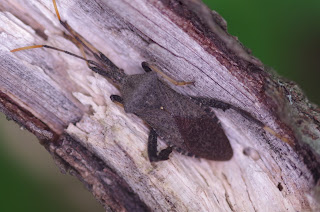Today I found this, though:
Discarded cicada exoskeleton. If you don't know about cicadas, here's the deal: they spend most of their lives underground as nymphs. The amount of time they spend underground depends on what species they are–there are one year cicadas, and 17-year cicadas, and some variations in between (I think). So what happens is, at the end of their underground nymph stage, they crawl out of the ground and up a tree (generally the tree whose roots they have been feeding on as a nymph). On the tree they molt, and emerge as an adult. The adults make a lot of noise trying to attract a mate (I am not sure if both sexes do this, or just one calls), then they mate and lay eggs. I think they lay the eggs in the tree, and when they hatch, the nymphs drop to the ground, burrow in, and spend their lives under the dirt. The adult stage of their lives is very short. Anyway, this is a molted skin. During the years of the 17-year cicadas, when millions of them emerge all at once, in the areas where they emerge you will find the ground littered with these discarded skins. The one-year cicadas don't come out in such numbers, and I think this is the only one I have ever found in my backyard. It was attached to a leaf.
You can see the split up the back where the adult emerged.
Backyard Bug of the Day:
Caterpillar. I haven't been seeing a lot of caterpillars this summer (except for monarchs, obviously).
Caterpillar close-up
Once again I managed to miss the chrysalis transformation of one of my caterpillars, but this time I caught the tail end of the process. It had wriggled out of its skin, and was wiggling and twisting to get the skin completely off:
Here you can kind of see the face part of the skin, and the "antennae".
Finally, the skin dropped off. At this point it settles down and becomes a much less active process. I don't know how long it takes for it to completely contract into the final chrysalis shape; it's pretty gradual, and takes a while.
Another female (or the same, for all I know) was back laying eggs today, and feeding on the milkweed flowers.
And speaking of insect eggs:
Baby stinkbug hatchlings. I think the smaller ones are newly hatched, and the bigger ones are a little older? It looks like there are some discarded skins, too, so maybe the bigger ones have had a molt already? I don't know, this is the scene as I found it on the side of my garden shed. It looks like there are a couple of eggs that have not opened yet.
I saw about 5 or 6 damselflies today, which is a lot for one day. Most of them were in the same area of the yard where I usually see them, but I saw one elsewhere, too. I didn't get pictures of all of them, just two.
Here's the snoweberry clearwing hummingbird moth egg that was laid yesterday.
Leaf-footed bug
I almost didn't notice this hopper.
Jagged ambush bugs
Weevil and bumblebee
Robber fly
Arachnid Appreciation:
.
.
.
.
.
.
.
.
.
.
.
.
My husband mentioned as we were eating lunch outside that he has noticed that I have not posted a lot of spiders this summer. I haven't seen a lot of spiders this summer. This one, however, I found very easily, as its web was stretched across the path.





























No comments:
Post a Comment